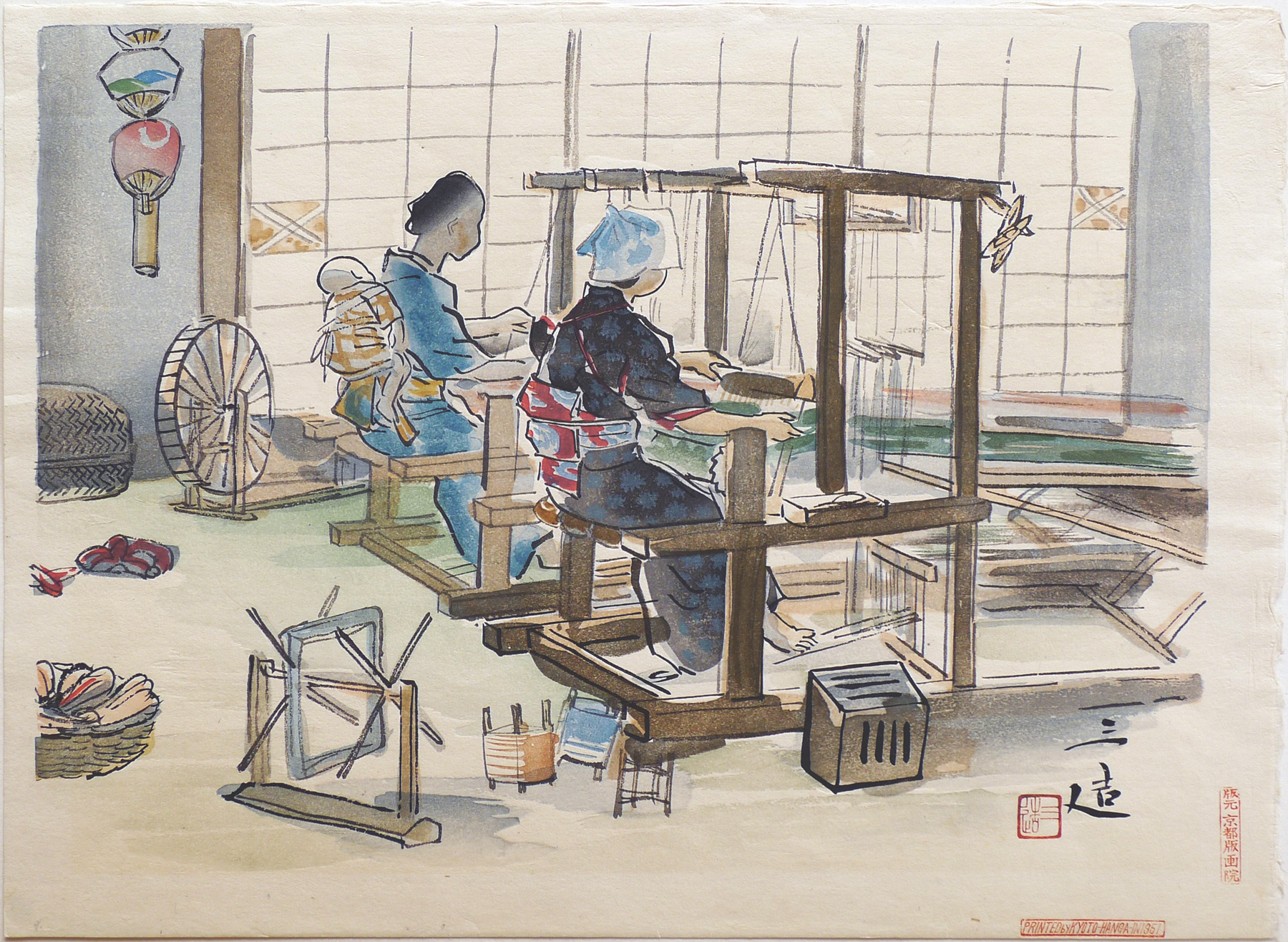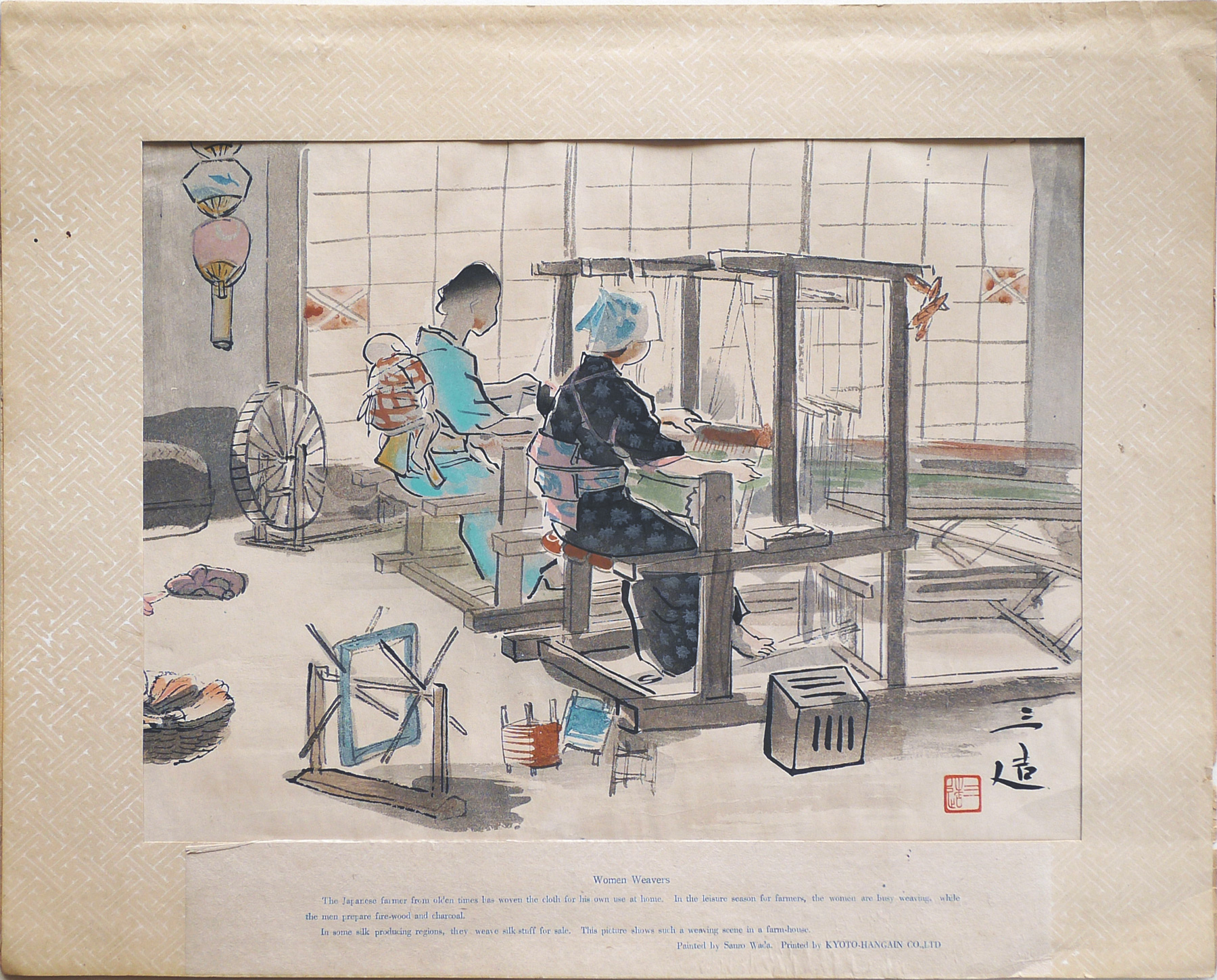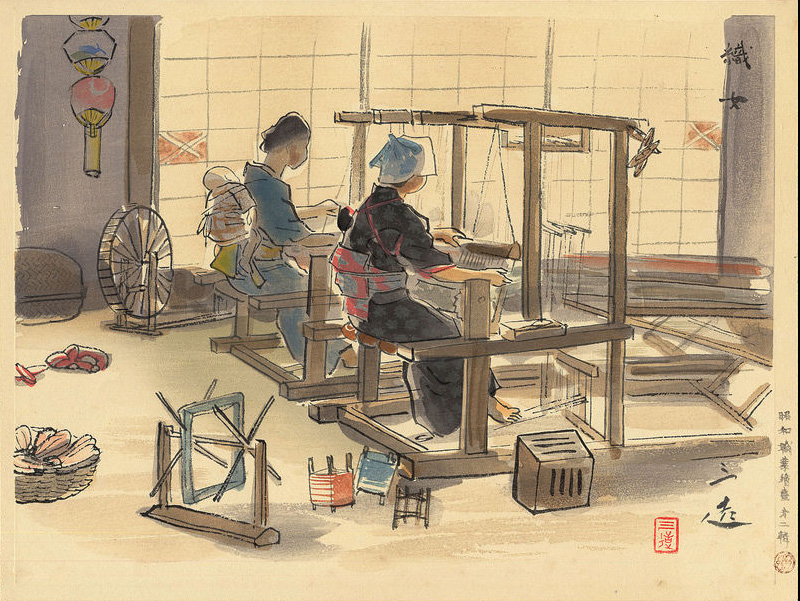About This Print
[First Edition, 1940, published by Nishinomiya Shoin] The Female Weaver (Women at the Loom)
Weaving is one of the occupations I favor most for women. It is eminently suited to the domestic scene. In times past it was regarded as essential, especially in the country districts, that all should have some knowledge of the handicrafts of weaving and dyeing.
One of the chief reasons of recommending this art to women is that one of the peculiar virtues of weaving is the encouragement it affords for the discussion of individual tastes and interests. Furthermore, there is developed by application to this art a sincere appreciation of mathematical concepts and a sense of the value of spiritual constancy.
While they ply their looms their thoughts may turn to cherished ones far away and in peace of mind they may learn to appreciate more deeply the value of serenity and tranquil effort. Deft and abstracted notions which result in the production rich and valuable fabrics provide their own culture and discipline.
Finally, the shuttles of the loom as they hum back and forth recall the chorus of the birds and bring to mind once more the peaceful quality of early spring.
[Second Edition, c. 1950, published by Kyoto Hangain]
Women WeaversThe Japanese farmer from olden times has woven the cloth for his own use at home. In the leisure season for farmers, the women are busy while the men prepare fire-wood and charcoal.In some silk producing regions, they weave silk stuff for sale. This picture shows such a weaving scene in a farm house. - Painted by Sanzo Wada.Printed by KYOTO-HANGAIN CO., LTD
A Critical View
Source: Light in Darkness: Women in Japanese Prints of Early Shōwa (1926-1945), Kendall H. Brown, et. al., Fisher Gallery, University of Southern California, 1996, p. 80.
After 1937, the war created a shortage of male labor and women were often hired to take the place of men although at far lower wages. Despite becoming invaluable to the work force, women were not represented as such in most popular art of the period. Tellingly, while women working in spinning mills were not depicted in woodblock prints, the old-fashioned weaver was the subject of representation. In Women Weavers (cat. 93) for his Occupations series, Wada Sanzō portrays these women not as part of the modern industrialized world but as members of a pre-industrial society. They are not factory workers but women casually working in a domestic setting. Once woman carries a baby on her back, underscoring the female’s maternal role. This depiction of the mother at work negates the dangerous and decidedly un-nurturing environments of most work places. In short, these women seem to labor of their own volition and in the spirit of craft rather than commerce. This image of women at work as it existed in the romanticized past is emphasized in Wada’s own comments accompanying the print:
“While they ply the loom their thoughts may turn to cherished ones far away and in peace of mind they may learn to appreciate more deeply the value of serenity and tranquil effort…. Finally, the shuttles of the loom as they hum back and forth recall the chorus of the birds and bring to mind once more the peaceful quality of early spring.”
In this print, Wada abjures the poverty, decrepit working conditions, and diseases characteristic of the spinning mills. By depicting weavers instead of factory workers, Wada camouflages the true conditions in the industrial environments and even denies their existence by using an image of two domestic weavers to represent the modern “occupation” of weaving.
First edition issued in 1940 by Nishinomiya Shoin A post WWII re-issue in a smaller (chuban) format by
the publisher Kyoto Hangain. One of six chuban size prints
in the series Japanese Life and Customs.
IHL Cat. #1127
About the Series "Occupations of Shōwa Japan in Pictures"
Sources: website of Ross Walker Ohmi Gallery http://www.ohmigallery.com/DB/Artists/Sales/Wada_Sanzo.asp and website of USC Pacific Asian Museum "Exhibition - The Occupations of Shōwa Japan in Pictures: The Woodblock Prints of Wada Sanzō"
Note:
My special thanks to Shinagawa Daiwa, the current owner of Kyoto Hangain, for providing the below information (in a series of emails in July 2014) about Nishinomiya Shoin and Kyoto Hangain, both businesses started by his father Shinagawa Kyoomi. Shinagawa's current website can be accessed at http://www.amy.hi-ho.ne.jp/kyotohangain/
2 "Out of the Dark Valley: Japanese Woodblock Prints and War, 1937-1945," Kendall H. Brown,p. 82 appearing in Impressions, The Journal of the Ukiyo-e Society of America, Inc., Number 23, 2001.
3 Pacific Asia Museum website http://www.pacificasiamuseum.org/_on_view/exhibitions/2004/occshowa.aspx
4 Light in Darkness: Women in Japanese Prints of Early Shōwa (1926-1945), Kendall H. Brown, et. al., Fisher Gallery, University of Southern California, 1996, p. 18.
Print Details
| IHL Catalog | #1002, #1023 | ||
| Title/Description | 織女 [shokujo] - Women Weavers [number 5] | ||
| Series | Occupations of Shōwa Japan in Pictures, Series 2 (also seen translated as "Compendium of Occupations in the Shōwa Era" and "Japanese Vocations in Pictures") Shōwa shokugyō e-zukushi 昭和職業繪盡 (also seen written as 昭和職業絵尽し and 昭和職業繪盡し), dainishū (第二輯) | ||
| Artist | Wada Sanzō (1883-1967) | ||
| Signature | 三造 Sanzō | ||
| Seal |
| ||
| Publication Date | c. 1950 (originally 1940) | ||
| Publisher |
| ||
| Edition | A second edition of the print first published by Nishinomiya shoin in 1940. As originally issued my Nishonimiya shoin this print was the 5th in series 2. It is believed that all the pre-WWII woodblocks for this series were destroyed in Allied air raids in 1945 and that all post-WWII impressions by Kyoto Hangain, the business started by Daiwa Shinagawa the owner of Nishomiya shoin after WWII, were made from re-cut blocks. | ||
| Carver | |||
| Printer | Ōno 大野 | ||
| Impression | IHL Cat. #1002 - excellent IHL Cat. #1023 - excellent | ||
| Colors | IHL Cat. #1002 - excellent IHL Cat. #1023 - excellent | ||
| Condition | IHL Cat. #1002: good - minor wrinkling and toning IHL Cat. #1023: excellent - mounting residue verso top corners | ||
| Genre | shin hanga | ||
| Miscellaneous | originally released by Nishinomiya Shoin as print number 5 in series 2 | ||
| Format | dai-oban | ||
| H x W Paper | IHL Cat. #1002: 11 3/4 x 15 1/2 in. (29.8 x 39.4 cm) IHL Cat. #1023: 11 1/2 x 15 3/4 in. (29.2 x 40 cm) | ||
| H x W Image | IHL Cat. #1002: 10 3/4 x 14 3/8 in. (27.3 x 36.5 cm) IHL Cat. #1023: 10 1/2 x 14 3/8 in. (26.7 x 36.5 cm) | ||
| Collections This Print | Himeji City Museum of Art Ⅲ-184-5 (dated "1939~1940年"); San Diego Museum of Art 1965.77.r | ||
| Reference Literature | Light in Darkness: Women in Japanese Prints of Early Shōwa (1926-1945), Kendall H. Brown, et. al., Fisher Gallery, University of Southern California, 1996, p. 81, cat. 93; Memories of Shōwa: Impressions of Working Life by Wada Sanzō, Maureen de Vries and Daphne van der Molen, Nihon no hanga, 2021 |










 hanmoto Kyoto Hangain suru Ōno
hanmoto Kyoto Hangain suru Ōno